#kazakhstan🇰🇿
Text




Asian Sweet Eyes Candies 🍭💦❤️
#asian beauty#asian cutie#asian perfection#perfect body#beautiful face#beautiful asian women#curvy asian#asian perfect girl#kazakhgirl#kazakh beauty#kazakhstan🇰🇿
225 notes
·
View notes
Photo

Incoming today 10.1.2023 1. Thank you @explorer.heena for PPC'S of Goa philately , National Mathematics Day 22.12.22 2. Thank you @writingfromthewonderland For Beautiful new year 2023 card, 3. Thank you @balachandrakotian for December R.R. 4. @postcrossing by oxana from #kazakhstan🇰🇿 thank you. (at Anantapur, Andhra Pradesh) https://www.instagram.com/p/CnOTUP0rEDT/?igshid=NGJjMDIxMWI=
0 notes
Photo

The park of 28 Panfilov Guardsmen is dedicated to and named after Panfilov heroes which were 28 soldiers of an Alma-ATA infantry unit who allegedly died while defending Moscow from the German invasion during Second World War. The Park of 28 Pánfilo Guardsmen is an urban park located in Almaty in the area surrounding the Ascension Cathedral. #28panfilovheroespark #28panfilov #almaty #kazakhstan #kazakhstan🇰🇿 #travel #explore #adventure #adventures #travelagency #gratefulforheroes (at Almaty Kazakistan 28 Park) https://www.instagram.com/p/ChSLDJhqtEY/?igshid=NGJjMDIxMWI=
#28panfilovheroespark#28panfilov#almaty#kazakhstan#kazakhstan🇰🇿#travel#explore#adventure#adventures#travelagency#gratefulforheroes
0 notes
Photo
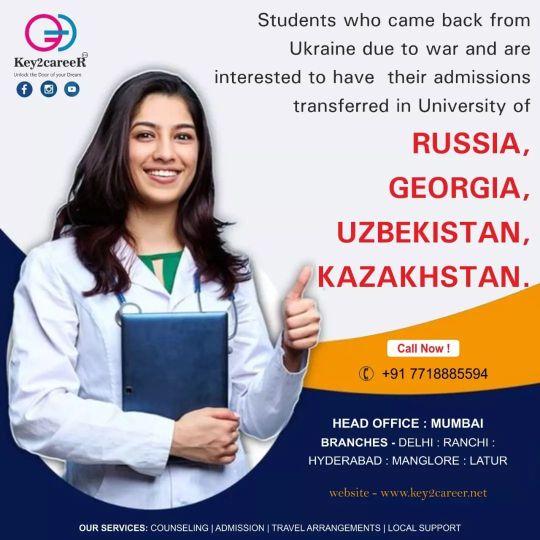
For further information contact Key2careeR Study Abroad Consultants Contact on - 7718885594 Mail us 📬 - [email protected] #russiauniversity #georgia #uzbekistan🇺🇿 #kazakhstan🇰🇿 #transfermbbs #mbbsabroad #transferfromukraine
0 notes
Text

A Male Saiga Antelope in Russia's Black Land National Park. These highly social antelope live in herds. Photograph By Valeriy Malee/Nature Picture Library
This Floppy-Nosed Antelope Was Nearly Gone. 20 Years Later, It’s Thriving.
Less than a decade ago, more than half of the world’s saiga antelope were lost to a mysterious disease. Its comeback is a rare and phenomenal conservation success.
— By Jason Bittel | December 14, 2023
Just two decades ago, it seemed as if we might need to write a eulogy for the saiga antelope.
Cut down by widespread poaching and waves of disease, by 2003, just 6 percent of the floppy-nosed ungulates remained in Kazakhstan, Mongolia, Russia, and Uzbekistan.
But today, scientists are rejoicing at the saiga’s unlikely rebound.
There are now 1.9 million saiga antelope across Eurasia, according to the most recent estimates released this week. So many saiga, in fact, that the International Union for Conservation of Nature is upgrading the Red List status for the species from critically endangered to near threatened.
“There's a lot of conservation doom and gloom, and there isn't very much attention paid to conservation successes,” says E.J. Milner-Gulland, a conservation scientist at the University of Oxford and co-founder of the U.K-based Saiga Conservation Alliance. “It’s quite a vindication of 20 years of hard work by lots of people.”
To get a sense of just how far this species has come, in 2015, more than half of the worldwide population of saiga antelope were lost to a mysterious blood disease.
“This is phenomenal news,” says Joel Berger, an ecologist at Colorado State University and a senior scientist at the Wildlife Conservation Society, in an email.
“At a time when so many species and populations are in deep swan dives, to witness the recovery of saiga—a species deserving of more recognition in its own right—is something we all need to celebrate,” he says.
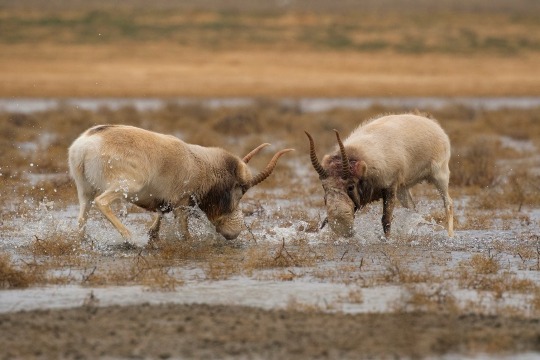
Male Saiga Antelope Battle in Black Lands National Park. Males and their horns are a specific target of poachers. Photograph By Valeriy Malee/Nature Picture Library
The Saiga’s Downward Spiral
Those who have been paying attention to the saiga’s saga know that it’s been a wild ride.
“Twenty years ago, it had the fastest increase in threat status of any mammal,” says Milner-Gulland. “The population had plummeted by more than 90 percent over a really short time of a few years, so it went straight in at critically endangered.”
As for what happened, Milner-Gulland explains that the saiga’s downfall can be attributed to several factors. For starters, saiga horn has great value in China, Singapore, Vietnam, and Malaysia as a component in traditional medicine. And this demand, coupled with the breakup of the Soviet Union, led to a dramatic rise in hunting.
It’s a Symbol of the Wild Steppe, of Independence and Freedom.
— E.J. Milner-Gulland, Conservation Scientist at the University of Oxford
“The economies of these countries basically collapsed,” she says. “And they were living in very harsh conditions on the steppe. So they turned to poaching.”
Fencing along the border between Kazakhstan and Uzbekistan also put a barrier in the middle of the saiga’s migratory route, while infrastructure development cut into saiga habitat. Finally, an unknown trigger turned a naturally occurring microbe in the saiga’s characteristic nose into a virulent pathogen, leading to the mass die-offs.
It’s for all these reasons that the IUCN has chosen not to de-list the saiga completely.
“The near threatened category is right for the saiga, because we know that at any time, we could just get large numbers of them dropping dead again,” says Milner-Gulland. “They are very vulnerable.”
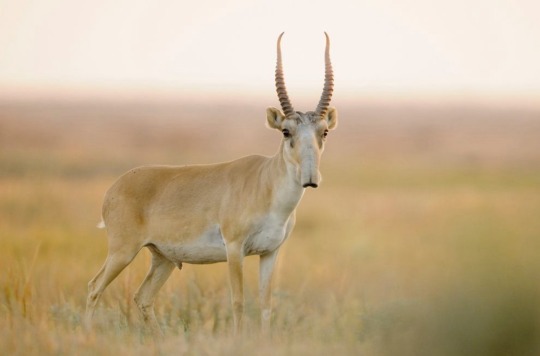
A Path to Recovery
Just as the threats to the saiga were multi-faceted, so too have been the efforts to protect the species, which are important seed dispersers and grazers that contribute to plant biodiversity.
For instance, an international collaboration between countries where saigas roam, countries that traditionally consume saiga products, and other stakeholder nations, including the United States, led to a memorandum of understanding in 2006 to conserve the species, restore its habitat, and restrict harvest to a sustainable level.
For its part, Kazakhstan’s government focused on stronger anti-poaching measures, including law enforcement to prevent saiga hunting. The Saiga Conservation Alliance supplied financing for gasoline, uniforms, motorbikes, and shelters for those rangers, who live in the harsh, windswept grasslands. Customs agents also improved detection of saiga products leaving the country as part of the illicit wildlife trade. Lastly, the country designated multiple protected areas totaling more than 12 million acres of saiga antelope habitat.
Now that economic conditions have leveled out and local people don’t have to choose between their own survival and saving saiga, there has also been a dramatic shift in support for the species.
“The thing about saiga is the local people really love it,” says Milner-Gulland. “It’s a symbol of the wild steppe, of independence and freedom.”
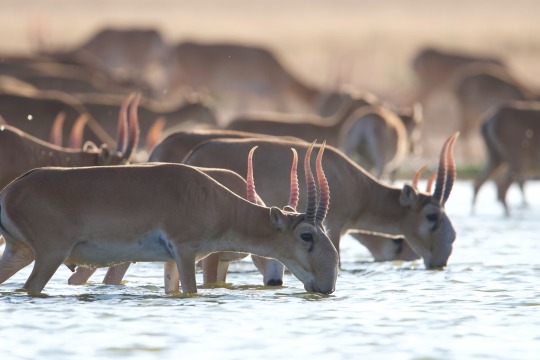
Saiga (Drinking on Southern Russia's Astrakhan Steppe) can migrate up to 600 miles over summer and winter. Photograph By Valeriy Malee/Nature Picture Library
#Animals 🦓 🦒 🐘#Floppy Nosed Antelope#Kazakhstan 🇰🇿 | Mongolia 🇲🇳 | Russia 🇷🇺 | Uzbekistan 🇺🇿#University of Oxford#Saiga Antelope#China 🇨🇳 | Singapore 🇸🇬 | Vietnam 🇻🇳 | Malaysia 🇲🇾#E.J. Milner-Gulland | Conservation Scientist | University of Oxford
41 notes
·
View notes
Text
🇰🇿🦅

I love them.
8 notes
·
View notes
Text










Kazakhstanian 🇰🇿 tennis 🎾 babe Elena Rybakina ❤️❤️
#sexy#beautiful#models#lingerie#beauty#lacy#see through#long hair#silky#Tennis 🎾#Kazakhstan 🇰🇿#Elena Rybakina#Wimbledon champion
2 notes
·
View notes
Text
Hi dude. I'm here with news from the world.
"Ataturk park and Ataturk statue" was opened in Almaty, Kazakhstan for the 100th anniversary of the Republic of Turkey.
This news must have touched the Turks 😭.

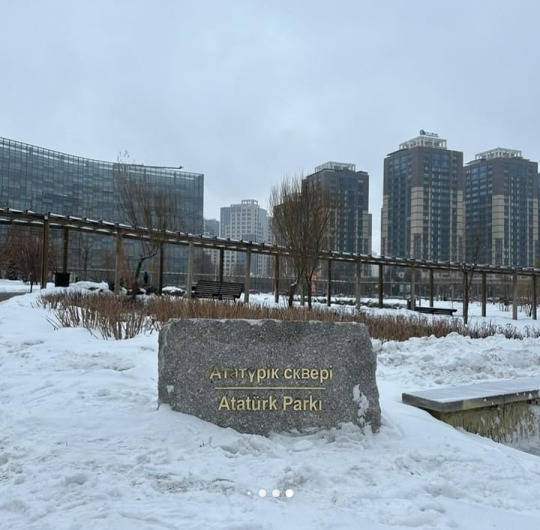

2 notes
·
View notes
Text

Kazakh woman 🇰🇿
#kazakh woman#kazakhstan#Қазақстан Республикасы#🇰🇿#sdxl#stable diffusion#stablediffusion#ai#ai generated#ai woman
1 note
·
View note
Video
youtube
Youngsters ~ ARIGATO [Kazakhstan 🇰🇿]
More Youngsters
0 notes
Text

Homemade 🇰🇿Kazakh Shalgam Salad. Healthy and delicious!
#foodie#food#foodblogger#chef#homecook#delicious#healthy food#cooking#🇰🇿#kazakhstan#kazakh culture#kazakh food#kazakhfood#central asia#Казахстан#salad#shalgam#daikon#carrot#colours#colors#aesthetics#food aesthetic#food photography#beautiful food#healthy salad recipes#healthy salads#keto#keto diet#keto food
1 note
·
View note
Text

Asian Sweet Eyes Candies 🍭💦❤️
#asian beauty#asian cutie#asian perfection#perfect body#beautiful face#beautiful asian women#curvy asian#asian perfect girl#kazakhstan🇰🇿#kazakh beauty#kazakhgirl#kazakhstan
21 notes
·
View notes
Photo
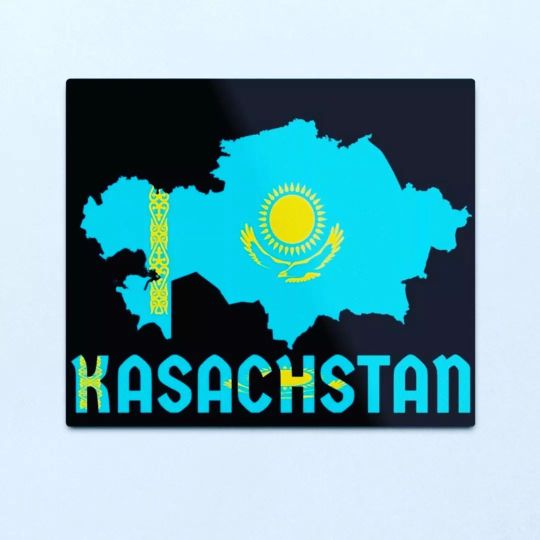
Map of Kazakhstan + Registration in German #kazakhstan #deco #europe #asia #almaty #astana #stancountry #accessory #flagofkazakhstan #findyourthingredbubble #kasachstan #kasachstan🇰🇿 #kazakh #artmap #mapprint #instaart #instaartwork @travel.kazakhstan @kasachstan.aus.memes @kasachstanreisen #formerussr #ussrmemes #borders #tshirt #livingroom https://www.instagram.com/p/CnLap-bIvou/?igshid=NGJjMDIxMWI=
#kazakhstan#deco#europe#asia#almaty#astana#stancountry#accessory#flagofkazakhstan#findyourthingredbubble#kasachstan#kasachstan🇰🇿#kazakh#artmap#mapprint#instaart#instaartwork#formerussr#ussrmemes#borders#tshirt#livingroom
0 notes
Photo

Kok Zhailau is a plateau in the territory of the Ile-Alatau State National Natural Park, 10 km from the Almaty. It’s a popular tourist attraction. Shymbulak, Medeu and Big Almaty lake can be seen from the platea. #kokzhailau #kokzhailaualmaty🌿🍃🌾🍂🍁 #almaty #kazakhstan #kazakhstan🇰🇿 #travel #adventure #adventures #explore #travelagency (at Kok-Zhailau resort) https://www.instagram.com/p/ChSJg2fqfK6/?igshid=NGJjMDIxMWI=
#kokzhailau#kokzhailaualmaty🌿🍃🌾🍂🍁#almaty#kazakhstan#kazakhstan🇰🇿#travel#adventure#adventures#explore#travelagency
0 notes
Photo

3 -4 декабря, 2022 года, в Казахстане, городе Шымкенте и городе Туркистане пройдёт международный фестиваль "Дустлик-2022", под девизом " Объединяя народы, мы укрепляем дружбу". #kazakhstan #shimkentcity #astana #almaty #казахстан🇰🇿 #шымкент #алматы #фестиваль #дружбанародов #шымкентсити (at Kazakhstan) https://www.instagram.com/p/ClYTJWfsY1Z/?igshid=NGJjMDIxMWI=
#kazakhstan#shimkentcity#astana#almaty#казахстан🇰🇿#шымкент#алматы#фестиваль#дружбанародов#шымкентсити
0 notes
Text
Amid Global Transitions, Kazakhstan is an Emerging Swing Player
Kazakhstan is assuming an increasingly important role amid a global energy transition and regional diplomatic shifts.
— By Eugene Chausovsky | Published November 29, 2023
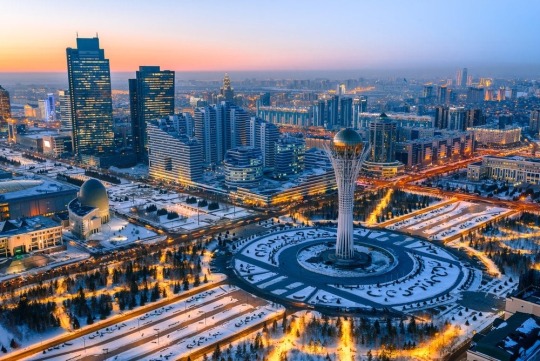
Image Credit: Shutterstock
From the landmark Biden-Xi Summit in San Francisco to the upcoming COP28 UN Climate Change Conference in Dubai, November is proving to be a busy month for global diplomacy. Both events highlight some of the world’s biggest challenges at this time, from the increasingly contentious U.S.-China relationship to the disruptions associated with climate change and the management of the global energy transition. One country that may play a surprisingly important role in shaping each of these major themes in the coming months and years is Kazakhstan.
Located in Central Asia, Kazakhstan sits astride strategic real estate in the middle of the Eurasian supercontinent. The country has long borders with both Russia and China, and it is a significant producer and exporter of energy sources like oil, natural gas, and uranium. The combination of this location and resources has made Kazakhstan of substantial interest to external powers, most notably its two giant neighbors. Russia has had influential ties to Kazakhstan for centuries and remains an important trade and security partner. In the meantime, China has emerged as a significant economic player in Kazakhstan over the past decade. Chinese president Xi Jinping even announced the launch of the flagship Belt and Road Initiative (BRI) in Astana in 2013.
More recently, Kazakhstan has been building ties with other important players as it pursues a “multi-vector” foreign policy. Russia’s full-scale invasion of Ukraine in Feb 2022 and Moscow’s associated standoff with the West, along with China’s economic slowdown, have exposed the dangers of relying too heavily on its immediate neighbors. As such, Kazakhstan has sought to diversify its ties around the world, increasing diplomatic and economic engagement with various regional and global players, ranging from Turkey and the Gulf states to the United States and European Union.
Such engagement should not be seen simply as a replacement for Kazakhstan’s ties with either Russia or China. Instead, it reflects the global shift to an increasingly multipolar world, as well as Kazakhstan’s growing attractiveness to numerous influential players. Not only is the country a major producer and exporter of fossil fuels, but it is also a potentially pivotal player when it comes to the global energy transition to combat climate change. Kazakhstan contains significant deposits of critical minerals needed for solar, wind, and electric batteries (many of which are currently being sourced from countries like China and the Democratic Republic of Congo), and it could be a significant exporter of clean fuels like green hydrogen in the future.
And just as the world is going through the global climate transition and increasing multipolarity, Kazakhstan has been undergoing an essential transition of its own on the domestic front. President Kassym-Jomart Tokayev, who came into power in 2019 and succeeded the long-serving leader of Nursultan Nazarbayev, has pursued a democratic reform agenda in the country, which has included limiting presidential term limits, streamlining the process for establishing new political parties, and abolishing the death penalty. Tokayev, who previously served as Director-General of the UN Office in Geneva, has also pursued economic reforms and leveraged a European mentality to build up Kazakhstan’s ties with the West.
This was seen most recently during French President Emmanuel Macron’s meeting with Tokayev during a visit to Kazakhstan on November 1, during which the French leader acknowledged the country’s reform dynamics and thanked his counterpart for Kazakhstan’s adherence to Western sanctions imposed on Russia. The two leaders also signed economic deals, including a partnership agreement on rare earth minerals. A subsequent EU-Kazakhstan business forum held in Brussels on November 14 highlighted strong and growing trade and investment ties, noting Europe’s accelerating demand for critical raw materials.
In the meantime, Kazakhstan has also been developing stronger ties with the United States, with Tokayev participating in the first-ever head-of-state C5+1 summit between President Joe Biden and Central Asian leaders on the sidelines of the UN General Assembly in New York on September 19. This summit has been followed by working-level meetings between the United States and Kazakhstan, including the holding of the Kazakhstan-U.S. Enhanced Strategic Partnership Dialogue (ESPD) in Astana on November 6.
Following the announcement of plans to establish a C5+1 Critical Minerals Dialogue at the UNGA summit, discussions of “clean energy deployment and combating the climate crisis” featured heavily on the agenda for U.S. and Kazakh officials.
Thus, Kazakhstan is emerging as a significant player in the West’s climate transition plans, and it could prove to be an important weathervane for U.S.-China relations as well. Despite tensions between the two countries on issues like Taiwan and the Russia-Ukraine conflict, Xi and Biden did strike a more cooperative tone on climate change during their summit on November 15. This included a joint pledge by the world’s two largest economies to reduce greenhouse gas emissions and ramp up renewable energy production by 2030. Despite their competition in other areas, this could incentivize both Washington and Beijing to engage with Kazakhstan and elsewhere in Central Asia in a collaborative, or at least constructive, manner.
At the same time, there are risks that such climate cooperation between the United States and China can be reversed, as was the case following the visit of U.S. House Speaker Nancy Pelosi (D-CA) to Taiwan in August 2022. There are also risks that American efforts to compete with China’s BRI projects and general economic penetration in Kazakhstan could be seen by either Washington or Beijing as a zero-sum game, as opposed to Astana’s preference to pursue projects with both simultaneously.
Meanwhile, the role of Russia as a potential spoiler cannot be ruled out regarding U.S. and EU efforts to develop ties with Kazakhstan in what Moscow views as its “sphere of privileged influence.” With Kazakhstan unwilling to support Russia’s war in Ukraine, Moscow may look increasingly nervously at Astana’s efforts to build ties with other external players, especially those in the West. As such, the same dynamics that have made Kazakhstan more attractive could also make the competition over the country more dynamic.
Regardless, Kazakhstan is bound to play an influential role in many of the transitions that are currently underway, from the global energy transition to regional diplomatic shifts in Eurasia to what is an increasingly multipolar world. While it may not grab headlines during the Xi-Biden meeting or the COP28 summit at the end of this month, Kazakhstan could be a pivotal swing player in shaping the broader trends that underpin them for a long time to come.
— Eugene Chausovsky is a Senior Director at the New Lines Institute. Chausovsky previously served as a Senior Eurasia Analyst at the geopolitical intelligence firm Stratfor for more than ten years. His analytical work has focused on political, economic, and security issues pertaining to Russia, Eurasia, and China, as well as global connectivity issues related to energy and climate change.
#Kazakhstan 🇰🇿#Central Asia#Silk Road Rivalries#COP28#Climate Change#Russia 🇷🇺#China 🇨🇳#TheNationalInterest.Org
0 notes